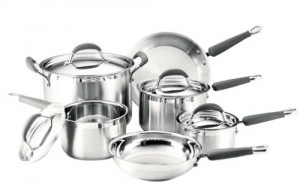The Cookware HeadQuarters
Best Cookware Reviews and Consumer Guide
Cookware Material Guide
Here we will look at the various type of cookware materials, its advantages and disadvantages with our recommendations. We will look at the following cookware material
- Cast iron
- Copper
- Non-Stick
- Stainless Steel
- Hard anodized
- Multi-ply or Clad
- Carbon Steel
- Enamel coated cast iron
- Enamel over steel
——————————————————————————————————————
Cast Iron
Cast Iron can withheld high heating that makes it not only great for stove top cooking but also oven baking too. Cast Iron cookware are slow to heat up but once it hot, it holds its heat for longer period and great for even cooking. Cast Iron pans are great for searing and outdoor cooking as it holds heat better even if outside temperature fluctuates. If you season your cast iron pan, it can work almost like non-stick pan without chemical coating. It is not easy to maintain cookware though,… Continue reading
Other Cookware Materials : Cookware Tips and Guide
In addition to stainless steel, non-stick, cast-iron, copper, hard anodized, multi-ply or all-clad cookware, there are a few other types of cookware and bakeware material that some of you might be interested in. Let’s look at those materials in details. —————————————————————————————————————
Carbon Steel
Carbon steel cookware is usually rolled or hammered into tiny thin sheets of material. Material supposed to be strong and holds heat well enough. This type of material is best suited for knives, woks, crepe frying pan and paella pots, where curved shapes holds heating where required during stirring. One of the issue with carbon steel is that it need to be seasoned with oil before using and needs to be repeated as needed. Over time, the surface will be black and non-stick like cast-iron material.
Top Carbon Steel Kitchenware
See our detailed Wok Guide here: Wok… Continue reading
